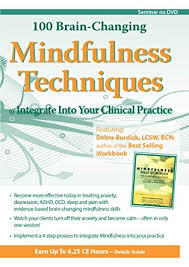Debra Burdick – 100 Brain-Changing Mindfulness Techniques to Integrate Into Your Clinical Practice
$200 Original price was: $200.$75Current price is: $75.
Shopping Instructions:
- DISCOUNT 15% : SHOP15
- Product Delivery: Within 1 – 12 hours after purchase.
Enhance your treatment plans for anxiety, depression, ADHD, OCD, bipolar disorder, sleep, pain, and stress with brain-changing mindfulness skills tailored to the problems your clients face each day.
Debra Burdick – 100 Brain-Changing Mindfulness Techniques to Integrate Into Your Clinical Practice
- Become more effective in treating anxiety, depression, ADHD, OCD, sleep and pain by incorporating mindfulness skills with evidence-based treatments
- First session strategies for anxiety – calm your clients with mindfulness interventions you can teach on their very first day of treatment!
- Implement a 4-step process to integrate Mindfulness into your practice
Enhance your treatment plans for anxiety, depression, ADHD, OCD, bipolar disorder, sleep, pain, and stress with brain-changing mindfulness skills tailored to the problems your clients face each day.
Watch this workshop and get detailed guidance on the hows, whys, and whens of incorporating core and advanced mindfulness skills into your clinical practice.Build your client education skills and improve therapeutic engagement with clear explanations regarding the neurobiology behind mindfulness. Interactive demonstrations and step-by-step instruction on specific interventions and exercises will give you the tools you need to treat a variety of disorders and populations. And the opportunity to practice under the direction of our instructor will boost your confidence in using your new skills. Better still, you’ll walk away with a four-step process that ties it all together, making what you’ve learned immediately relevant to your own work with clients.
- Motivate clients to engage in treatment with understandable psychoeducational explanations regarding the research and practices associated with mindfulness.
- Formulate treatment plans for anxiety that include mindfulness techniques that can be used to regulate the client’s arousal state.
- Integrate mindfulness interventions into therapy that can help depressed clients manage negative thoughts and reduce the risk of relapse.
- Articulate how mindfulness training can be used as an adjunctive therapy with evidence-based treatment to enhance attention in clients with attention deficit hyperactivity disorder (ADHD).
- Communicate how mindfulness-based approaches can help clients observe internal reactions and establish how this information can be used in the treatment of posttraumatic stress symptoms.
- Instruct clients with obsessive-compulsive disorder (OCD) on the utilization of mindfulness skills that can facilitate disengagement from repetitive thoughts.
Would you like to receive Debra Burdick – 100 Brain-Changing Mindfulness Techniques to Integrate Into Your Clinical Practice ?
From Mindfulness
- What is Neuroplasticity and why do we care?
- Cutting edge research that proves
- Mindfulness changes the brain for specific disorders
Clinical Application of Mindfulness Strategies to Specific Disorders
- Anxiety
- Calm the arousal state and relax mind and body
- Reduce anxious thoughts
- Focus on the present
- Depression
- Notice and decrease negative thoughts
- Shift and improve mood state
- Increase pleasure
- PTSD
- Notice and calm the arousal state
- Improve ability to stay grounded in the present
- Reduce traumatic thoughts
- Panic
- Abort and prevent panic attacks
- Reduce frequency and intensity of panic attacks
- Bipolar Disorder
- Increase awareness of mood state
- Stabilize mood over time
- OCD
- Increase awareness of obsessive thoughts and compulsive behaviors
- Decrease obsessional thinking and compulsions
- ADHD
- Improve concentration
- Increase task completion
- Reduce hyperactivity
- Stress
- Calm the arousal state
- Lower the stress response
- Anger
- Increase awareness of thoughts, emotions and physical body
- Manage anger
- Reduce intensity and frequency of anger
- Pain
- Accept and embrace the pain
- Relax around the pain
- Distract from pain
- Remember wellness
- Sleep
- Calm busy thoughts
- Relax the mind and body
- Fall asleep and stay asleep
How to Integrate Mindfulness into Clinical Practice
- Introduce Mindfulness to Clients
- How to do the exercises with your client
- Techniques to increase client use of
- Mindfulness at home
- Strategies for processing what happens with your client
- Strategies to identify and overcome obstacles and resistance
Related products
NLP & Hypnosis
NLP & Hypnosis
NLP & Hypnosis
NLP & Hypnosis
NLP & Hypnosis












